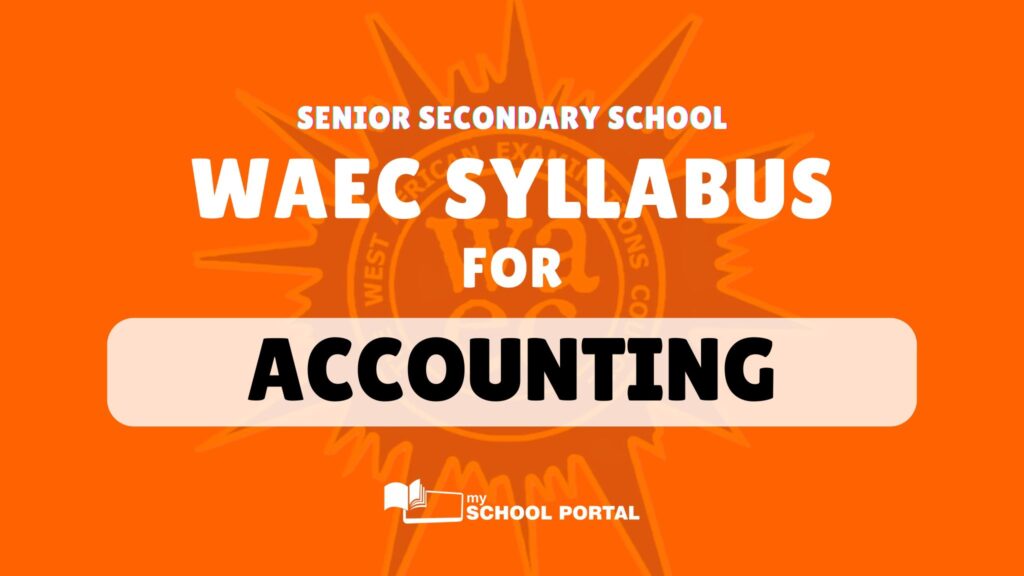The WAEC Syllabus for Accounting examination is drafted to assess candidates’
- Understanding of accounting principles and the role of accounting in recording business transactions;
- Appreciation and application of the rules and functions of Accounting as they apply to organization;
- foundation for further studies in Accounting
There will be two papers – Paper 1 and Paper 2, both of which will constitute a composite paper to be taken at one sitting. Paper 1 will comprise fifty multiple choice questions, all of which should be answered in 1 hour for 25 marks. Paper 2 will be made up of two sections, Sections A and B and will last 2½ hours. Section A will contain four essay questions on Theory of Financial Accounting. Candidates will be required to answer two out of the four questions for 15 marks each. Section B will contain five essay questions on Financial Accounting Practice. Candidates will be required to answer three out of the questions for 15 marks each.
Detailed WAEC Syllabus for Accounting
- Introduction to Financial Accounting
- History, nature and functions of Accounting.
- Users of Accounting information.
- Stages in the Accounting process.
- Characteristics of Accounting information
- The Accounting Equation and Double Entry Principles
- Accounting Equation.
- Purpose and functions of source documents.
- Subsidiary books.
- The ledger: classification of Accounts.
- Cash Book: analytical cash book, including petty cash book.
- Preparation of Trial Balance.
- Bank Reconciliation Statements
- Correction of errors and Suspense Account
- Accounting Concepts
- Meaning.
- Types.
- Significance. Limitations
- The Final Accounts of a Sole Trader/proprietorship
- Trading, profit and loss accounts/Income statement.
- Balance sheet/statement of financial position.
- Adjustments to final accounts.
- Provisions and Reserves
- Provision for doubtful debts/Allowance for doubtful debts.
- Depreciation – concepts, reasons for recording and methods:
- straight line;
- reducing balance;
- sum of the years digits; revaluation
- Accounting for depreciation.
- Reserves – revenue and capital reserves
- Manufacturing Accounts
- Purpose of Manufacturing Accounts.
- Cost classification in Manufacturing Accounts.
- Preparation of final Accounts of Manufacturing concern.
- Control Accounts and Self- balancing Ledgers
- Meaning and uses of control accounts
- Types:
- sales ledger control
- purchases ledger control
- Preparation of Control Accounts
- Reconciliation of Control Accounts
- Single Entry and Incomplete Records
- Meaning and limitations
- Computation of profit or loss from opening and closing balance sheets.
- Conversion of singe entry to double entry.
- Preparation of final accounts from a set of incomplete records.
- Mark up and Margin
- Accounts of Not-for-Profit Making Organizations
- Meaning and terminologies.
- Receipts and payments accounts.
- Subscriptions Account
- Income and expenditure accounts.
- Accumulated fund.
- Balance sheet.
- Profit or loss from income generating activities.
- Partnership Accounts
- Nature and formation of partnership.
- Partnership agreements/Deed.
- Profit and loss appropriation accounts.
- Partners capital account and balance sheet
- Admission of a new partner.
- Treatment of goodwill and revaluation of assets Dissolution of partnership (Questions will not be set on Garner V. Murray and piecemeal realization)
- Company Accounts
- Nature and formation of a company.
- Types of companies and shares.
- Issue of shares.
- Loan capital, debentures/loan notes and mortgages.
- Final accounts of company for internal use only.
- Interpretation of accounts using simple ratios.
- Purchase of business account.
- Statement of Cash Flow (using direct and indirect methods).
- Accounting for Value Added Tax
- Purpose of VAT
- Characteristics of VAT.
- Bases of computing input/output VAT.
- Preparation of VAT returns.
- Exempt goods and services
- Departmental and Branch Accounts
- Meaning and importance
- Differences between a department and branch
- Preparation of departmental account.
- Inter branch transactions.
- Public Sector Accounting
- Meaning and difference between Public Sector and Private
- Sector Accounts.
- Sources of public revenue.
- Capital and recurrent expenditures.
- Preparation of simple government accounts
- Information Technology in Accounting
- Manual and computerized Accounting Processing Systems.
- Processes involved in data processing.
- Computer Hardware and Software.
- Merits and demerits of manual and computerized accounting processing systems
- Miscellaneous Accounts
- Meaning, introduction, terminologies and preparation of simple:
- Joint Venture Accounts
- Consignment Accounts
- Contract Accounts Hire Purchase Accounts
- Meaning, introduction, terminologies and preparation of simple:
- Financial system
- Meaning and components.
- Meaning, functions and features of
- money market
- capital market
- insurance market
- Methods of raising funds from the capital market:
- offer for sale
- offer for subscription
- rights issue
- private placement
- Requirements for accessing the capital market.
- Benefits of capital market to:
- investors
- government
- economy
Recommended text books
- Business Accounting volume 1 (West African Edition by Frank Wood and Omunya)
- Accounting Volume 2 (Frank Wood.)
- Accounting and Finance (Frank Wood)
- Foundation Accounting (A. H. Millchamp)
- Basic Accounting J. D. Magee.
- Accounting for Senior Secondary School Amankwah. S. C. Malhorta, P. K. Botchweyand, P. A.
- Accounting in Business R. J. Bull.
- Company Accounts J. N. Amorin.
- Principles of Accounting K. B. Appiah Mensah
- Incorporated private Partnership Act 1962, Act 152.
Related
Stay updated with the latest student resources and insights from My School Portal! Subscribe to our newsletter for fresh content delivered straight to your inbox—no spam, just value 😊














